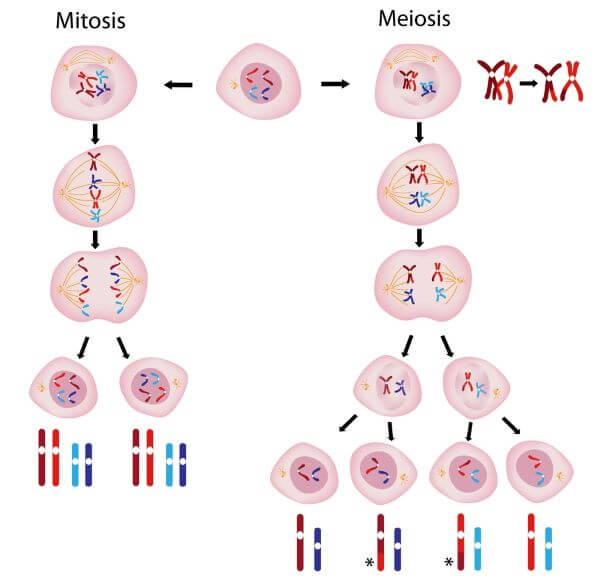
Project On Mitosis And Meiosis For Class 10
Introduction
Cell division, an intricate biological process, plays a pivotal role in the growth, repair, and reproduction of living organisms. Two primary mechanisms governing cell division are mitosis and meiosis. Mitosis is the mechanism by which a single cell divides into two identical daughter cells, serving as a linchpin for tissue growth and repair. In contrast, meiosis represents a specialized form of cell division, contributing to the formation of gametes, such as sperm and egg cells, and introducing genetic diversity through recombination, a prerequisite for sexual reproduction. This project endeavors to offer a comprehensive understanding of these two processes, emphasizing their disparities and importance.

Mitosis
Unveiling Mitosis: Mitosis stands as a foundational cellular process, facilitating the division of a parent cell into two genetically identical daughter cells. This process is of paramount significance in the growth and repair of multicellular organisms. Mitosis entails the replication of the parent cell’s DNA, culminating in the creation of identical chromosomes, followed by their segregation into two daughter cells. It predominantly transpires in somatic or body cells, assuring that each new cell retains the same genetic material as its precursor.
The Four Phases of Mitosis
Mitosis unfolds through four distinctive phases, each marked by specific events:
- Prophase: During prophase, the chromatin condenses into visible chromosomes, and the nuclear envelope begins to disintegrate. Concurrently, the mitotic spindle apparatus commences its formation.
- Metaphase: Metaphase witnesses the alignment of condensed chromosomes along the cell’s equatorial plane, referred to as the metaphase plate.
- Anaphase: In anaphase, sister chromatids, which are identical copies of each chromosome, are separated and directed toward opposite poles of the cell.
- Telophase: Telophase sees the segregated chromatids reaching opposite poles, followed by the emergence of new nuclear envelopes around them. Ultimately, the cell undergoes division into two daughter cells via a process called cytokinesis. Each daughter cell inherits the same genetic information as the parent cell.
Meiosis
Unveiling Meiosis: Meiosis, a specialized form of cell division, transpires in germ cells, which bear the responsibility for sexual reproduction. Unlike mitosis, meiosis culminates in the generation of four distinct daughter cells, each possessing half the number of chromosomes as the parent cell. This reduction in chromosome number is indispensable for preserving the accurate ploidy (number of chromosome sets) during sexual reproduction.
The Phases of Meiosis
Meiosis encompasses two sequential divisions: Meiosis I and Meiosis II.
Meiosis I
This division focuses on halving the chromosome count. During prophase I, homologous chromosomes pair and partake in recombination (crossing-over), exchanging genetic material. In metaphase I, these pairs align at the metaphase plate. Anaphase I segregates homologous chromosomes, propelling them to opposite poles, and telophase I yields two haploid daughter cells.
Meiosis II
Meiosis II shares similarities with mitosis but starts with haploid cells. It entails prophase II, metaphase II, anaphase II, and telophase II, each resulting in the separation of sister chromatids. Meiosis II culminates in four haploid daughter cells, each adorned with unique genetic combinations.
Distinctions and Comparisons
Discerning Mitosis from Meiosis: Mitosis begets two genetically identical diploid cells, whereas meiosis yields four genetically diverse haploid cells. Mitosis supports growth, repair, and asexual reproduction, while meiosis is exclusively dedicated to sexual reproduction. Mitosis encompasses a solitary division, whereas meiosis involves two divisions, contributing to the reduction in chromosome number.
Conclusion
In summation, mitosis and meiosis stand as indispensable processes in the realm of cell division. Mitosis fosters tissue growth and repair by bestowing two genetically identical daughter cells. Conversely, meiosis assumes a pivotal role in sexual reproduction by fashioning four haploid gametes, each distinguished by its unique genetic amalgamation. Comprehending the distinctions and significance of these two processes is paramount in comprehending the intricacies of life and inheritance.
Certificate of Completion
[Student’s Name][Class/Grade Level]This is to certify that I, [Student’s Name], a [Class/Grade Level] student, have successfully completed the project on “Mitosis And Meiosis For Class 10.” The project explores the fundamental principles and key aspects of the chosen topic, providing a comprehensive understanding of its significance and implications.
In this project, I delved into in-depth research and analysis, investigating various facets and relevant theories related to the chosen topic. I demonstrated dedication, diligence, and a high level of sincerity throughout the project’s completion.
Key Achievements:
Thoroughly researched and analyzed Project On Mitosis And Meiosis For Class 10.
Examined the historical background and evolution of the subject matter.
Explored the contributions of notable figures in the field.
Investigated the key theories and principles associated with the topic.
Discussed practical applications and real-world implications.
Considered critical viewpoints and alternative theories, fostering a well-rounded understanding.
This project has significantly enhanced my knowledge and critical thinking skills in the chosen field of study. It reflects my commitment to academic excellence and the pursuit of knowledge.
Date: [Date of Completion]Signature: [Your Signature] [School/Institution Name][Teacher’s/Examiner’s Name and Signature]
In order to download the PDF, You must follow on Youtube. Once done, Click on Submit
Follow On YoutubeSubscribed? Click on Confirm
Download Project On Mitosis And Meiosis For Class 10 PDF






